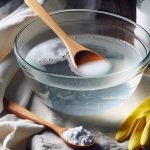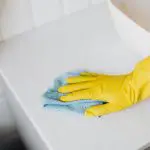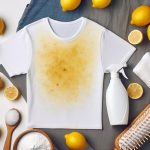Looking to brighten up your fabrics without using harsh chemicals? With 65% of households concerned about the environmental impact of cleaning products, it's no wonder that natural bleaching methods are gaining popularity.
In this guide, you'll discover five quick and effective bleaching hacks for fabrics. From using lemon juice and sunlight to harnessing the power of hydrogen peroxide, these methods are perfect for those seeking eco-friendly and budget-friendly solutions.
Whether it's removing stubborn stains or simply freshening up your linens, these fabric bleaching hacks are essential for anyone looking to master the art of natural cleaning.
Key Takeaways
- Lemon juice and sunlight can be used as a natural bleaching method for fabrics.
- Baking soda and vinegar soak is an effective way to bleach fabrics.
- Hydrogen peroxide can be used as a spot treatment for stains on fabric.
- Oxygen bleach powder soak is a reliable method for bleaching fabrics.
Lemon Juice and Sunlight Method
If you want to naturally bleach your fabrics, the lemon juice and sunlight method is a simple and effective way to achieve it. This method is one of the most popular natural bleaching alternatives and is known for its sunlight bleaching effectiveness.
The citric acid in lemon juice acts as a natural bleaching agent when activated by the sun's UV rays. To use this method, mix equal parts lemon juice and water in a spray bottle and saturate the fabric with the solution. Then, place the fabric in direct sunlight for several hours, allowing the lemon juice and sun to work their magic.
It's important to note that this method works best on light-colored fabrics and may not be as effective on darker colors. Additionally, prolonged exposure to sunlight can weaken fabrics, so it's essential to monitor the process to prevent damage.
Once the fabric has achieved the desired level of bleaching, thoroughly rinse and wash it to remove any remaining lemon juice. This simple yet effective method can help you achieve natural bleaching results without the use of harsh chemicals.
Baking Soda and Vinegar Soak
To bleach your fabrics using the baking soda and vinegar soak method, prepare a solution of water, baking soda, and vinegar in a container. This natural fabric brightening technique is known for its effective stain removal capabilities. Here's a simple guide to help you get started:
| Ingredients | Measurements |
|---|---|
| Water | 1 gallon |
| Baking Soda | 1 cup |
| Vinegar | 1 cup |
- Fill a container with 1 gallon of water.
- Add 1 cup of baking soda to the water and stir until it dissolves.
- Pour 1 cup of vinegar into the solution and mix well.
- Submerge your fabric in the solution and let it soak for 1-2 hours.
The combination of baking soda and vinegar creates a powerful cleaning solution that is gentle on fabrics yet effective in removing stains and brightening colors. Once the soaking time is up, wash the fabric as usual. This method is particularly useful for brightening whites and removing tough stains. Incorporating natural fabric brighteners and effective stain removal techniques into your laundry routine can help maintain the vibrancy and freshness of your fabrics.
Hydrogen Peroxide Spot Treatment
When treating fabric stains with hydrogen peroxide, apply a small amount directly to the affected area, gently rubbing it in with a cloth or sponge. Hydrogen peroxide is an effective stain remover, but it's important to use it carefully to ensure fabric safety.
Here are some key tips for utilizing hydrogen peroxide for stain removal:
- Spot Test: Before applying hydrogen peroxide to the entire stain, do a spot test on a small, inconspicuous area of the fabric to check for any adverse reactions.
- Dilution: If the fabric is colored or delicate, consider diluting the hydrogen peroxide with water to minimize the risk of discoloration or damage.
- Blot, Don't Rub: When treating the stain, remember to blot the area with the hydrogen peroxide solution rather than rubbing it vigorously, as rubbing can spread the stain or damage the fabric fibers.
- Time Sensitivity: Act quickly when dealing with stains. The longer a stain sits, the harder it becomes to remove, so prompt treatment is essential.
- Rinse Thoroughly: After the stain is removed, rinse the fabric thoroughly with water to ensure that all traces of hydrogen peroxide are removed.
Oxygen Bleach Powder Soak
Once you have successfully spot treated fabric stains with hydrogen peroxide, the next step is to consider an oxygen bleach powder soak for a more comprehensive bleaching process. Oxygen bleach powder, also known as all-fabric bleach, is effective in brightening and removing stains from colorfast fabrics.
To begin, dissolve the oxygen bleach powder in water according to the package instructions. Then, immerse the fabric in the solution and allow it to soak for the recommended time, usually about 6-8 hours or overnight. This pre-soak technique is particularly useful for heavily stained or discolored fabrics.
When using oxygen bleach powder, it's essential to ensure that the fabric is colorfast by conducting a small test in an inconspicuous area. Additionally, always follow the manufacturer's instructions to prevent damage to the fabric.
After the soaking period, thoroughly rinse the fabric with cold water to remove any remaining bleach solution. Finally, launder the fabric as usual.
Salt and Lemon Soak
After completing the oxygen bleach powder soak, you can explore the effectiveness of the salt and lemon soak for further fabric bleaching. This natural bleaching alternative offers several benefits of eco-friendly bleaching methods. Here's what you need to know:
- Gentle on Fabrics: The salt and lemon soak is gentle on delicate fabrics, making it suitable for a wide range of materials, including cotton, linen, and even silk.
- Brightening Effect: The combination of salt and lemon can help brighten white and light-colored fabrics, restoring their original vibrancy.
- Natural Disinfectant: Lemon has natural antibacterial properties, which can help disinfect and freshen fabrics without the use of harsh chemicals.
- Environmentally Friendly: Salt and lemon are natural ingredients that are environmentally friendly, making this method a sustainable choice for fabric bleaching.
- Easy Application: The salt and lemon soak is easy to prepare and apply, requiring minimal effort for effective fabric bleaching.
Frequently Asked Questions
Can These Bleaching Methods Be Used on All Types of Fabric, Including Delicate or Colored Fabrics?
Yes, these bleaching methods may not be suitable for all types of fabric, including delicate or colored fabrics. Consider fabric compatibility and colorfastness, as bleaching effectiveness varies and delicate fabrics can be damaged.
Are There Any Potential Risks or Damage to the Fabric When Using These Bleaching Methods?
Using bleach on fabrics carries potential risks and can cause damage. Consider the fabric type and the effects of sunlight exposure. Always test in an inconspicuous area before applying any bleaching method to ensure fabric safety.
How Long Should the Fabric Be Exposed to Sunlight When Using the Lemon Juice and Sunlight Method?
When using the lemon juice and sunlight method, the sunlight duration varies based on fabric color and type. Generally, lighter fabrics need less time, while darker ones may require longer exposure. The effectiveness of lemon juice depends on the fabric type.
Can These Methods Remove Tough Stains Like Blood or Ink From Fabrics?
Yes, tough stains like blood or ink can be removed from fabrics using natural or chemical bleaching options. For natural methods, lemon juice and sunlight work well, while chemical bleach can also effectively remove tough stains.
Are There Any Specific Safety Precautions to Take When Using Hydrogen Peroxide for Spot Treatment on Fabrics?
When using hydrogen peroxide for spot treatment on fabrics, safety precautions are essential. Protect the fabric's color and preserve its quality by spot testing first. Wear gloves and work in a well-ventilated area to ensure safe handling.
- Crumple Tie-Dye Technique: The Easiest Method for Unique Designs - July 13, 2025
- What Is Tie-Dye? Exploring the Art of Resist Dyeing - July 13, 2025
- 5 Easy Tie-Dye Techniques Anyone Can Master - July 13, 2025






